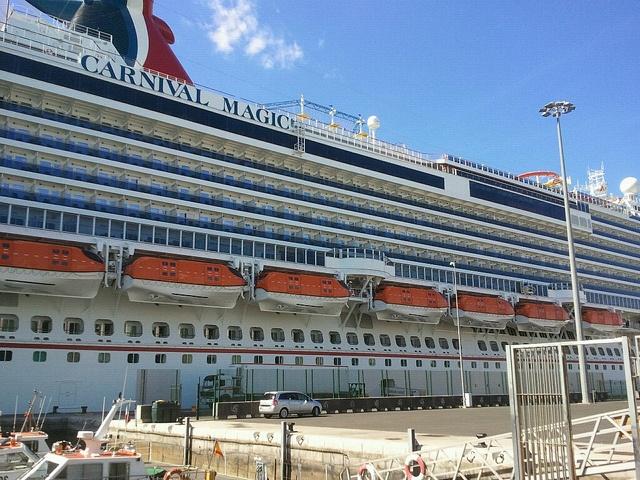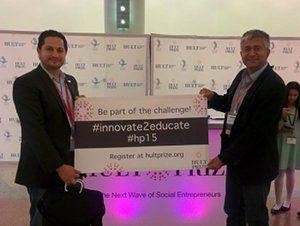TriplePundit's Guide to Buying Used Clothing


Want to save 700 gallons of water for under $10? The next time you buy a new shirt, make sure it’s secondhand. That’s right: According to the Natural Resources Defense Council, it takes 700-2,000 gallons of water to grow enough cotton to make your average cotton T-shirt. And growing cotton is just one small part of the tremendous overall environmental and social impact that the garment industry has on our planet.
But buying used clothing is a great way to opt out of the not-so-green fashion industry – and it’s often more affordable than purchasing environmentally and socially responsible new clothes, which can be quite pricey. Whether you’ve decided to start thrifting because of environmental or financial concerns or you just love the thrill of the hunt (or a combination of all these reasons), TriplePundit is here to help you get started, with our guide to buying secondhand.
Where to shop
Forget the stereotype of the dusty, dank thrift store; today, you’re likely to find secondhand clothes in a bright, clean thrift store, a clothing swap or through an app on your smartphone.
“I love Etsy for one-of-a-kind vintage pieces,” says Jasmin Malik Chua, managing editor of sustainable fashion blog Ecouterre. “Sites like Adored Vintage and Ballyhoo Vintage also do a bang-up job at curating secondhand items so they don't look like they belong in a jumble sale. For in-person shopping, there's Buffalo Exchange, Housing Works and even Goodwill on occasion.”
Don’t overlook the charity secondhand stores, as Chua points out; these shops give you a chance to find affordable threads while raising money for a good cause. At Out of the Closet’s locations in California, Washington, Ohio and Florida, sales from used clothing, shoes and accessories support free HIV testing, as well as medical care for patients with HIV/AIDS. Perhaps the best-known of all nonprofit thrift stores is, of course, Goodwill, which uses the revenue from its 2,900 retail locations and online auction to fund job training programs for youth, seniors, veterans and people with disabilities or criminal backgrounds. And, if you’re in the market for higher-end fashion but still want to support the organization’s good work, check to see if there is a Goodwill Boutique near you; these boutiques feature name-brand apparel at thrift store prices.
And while you can scour the racks at for-profit secondhand stores like Crossroads Trading Co., Buffalo Exchange or your local vintage store, you can also go online to shop used at sites like Etsy, as Chua mentions, thredUP, ReFashioner and the high-end Byronesque.
Clothing swaps are all the rage right now, Chua says, and give you the chance to not only pick up discounted, new-to-you fashions, but to also trade in your unwanted garments. The Global Fashion Exchange just hosted huge swap events in New York City and Los Angeles this fall, but look for in-person events at local consignment stores or organize your own swap party with your friends. Or pick up your smartphone or tablet and swap online; Bib + Tuck and Threadflip are two recommended swap sites from Sass Brown, acting associate dean for the School of Art and Design at the Fashion Institute of Technology in New York and author of “Eco Fashion” and “ReFashioned: Cutting-Edge Clothing from Upcycled Materials."
And if you are looking to trade in your old Patagonia gear or are in the market for discounted, used sportswear, check out the company’s Common Threads storefront on eBay where customers can buy or sell secondhand Patagonia items.
But one of the hottest trends in used attire doesn’t involve owning clothes at all. Just like men have been able to rent tuxedos for special occasions, Rent the Runway offers women the chance to borrow designer dresses and accessories for single use through its website or at its new retail locations.
Top thrifting tips
We asked three sustainable fashion experts, Chua, Brown and Johanna Bjӧrk, designer and founder and editor of Goodlifer, for their tips on buying used, and here's what they had to say:
Steer clear of fast fashion: Save the fast fashion fads for swapping websites, Brown says; when you’re shopping vintage, look for quality fabrics and manufacturing. Levi’s is one such brand, according to Desirae Early, manager of sustainability strategy and innovation at Levi Strauss & Co. Because of the jeans classic style and durability, Levi’s is one of the top sellers in secondhand stores around the world, Early says.
Know what size and style works best for your body: You can’t trust sizes in vintage stores, according to Bjӧrk: Pieces may have shrunk, been altered or come from a country with a different sizing system like the United Kingdom. Sizes have also changed over the years; today’s size 8 is not the same as a size 8 from the 1950s, she said.
“Learning to recognize — visually — what will fit you, will help you find those gems that fit like a glove, and save you time – and frustration – in the fitting room,” Bjӧrk says.
In a similar vein, Chua recommends that thrifters learn what eras of clothing and silhouettes fit their bodies best – to avoid looking like you’re wearing a Halloween costume to a dinner party.
Inspect, wash and repeat: Just like you would for any piece of new clothing you would buy, make sure to insect secondhand garments for holes, missing buttons and other defects before you make the final purchase, Chua says. You’ll also want to wash vintage duds before you wear them, especially if you want to get rid of that “old clothes” smell.
And finally, keep an open mind: Don’t enter a thrift store looking for that perfect yellow cocktail dress or double-breasted pinstripe suit; you will most likely never find it, Bjӧrk says.
“Thrifting is all about keeping an open mind and embracing the surprise element of what you happen to find that day,” she says. “My favorite thing about buying used clothing — besides that it’s cheap and environmentally responsible — is that you end up finding unique pieces that are not available anywhere else.”
Image credit: Goodwill Industries
Carnival Corporation Reduced Its Carbon Emissions By 20 Percent


Carnival Corporation, the world’s largest cruise company with nine brands, reduced carbon dioxide emissions by 20 percent from shipboard operations, a year ahead of its target. Its recently released 2013 Sustainability Report revealed that one way it reduced greenhouse gas emissions is through an exhaust cleaning technology called ECO-EGC. The system removes pollutants from exhaust gases. The company is installing the systems on over 70 percent of its fleet, and investing up to $400 million to design, build and install the systems on its ships.
Reducing fuel is important to Carnival, as the report shows. The company released the result of its Fleet Fuel Conservation Program which showed that by the end of this year it will have saved over one billion gallons of fuel and reduced carbon emissions from its fleet by 12 billion kilograms over the last seven years. The program has also improved its fleet’s overall fuel efficiency by 24 percent since 2007 and saved about $2.5 billion in fuel costs, the company’s largest expense.
Carnival has increased the number of ships it services from 79 in 2005 to 101 in 2013, but it has been able to reduce its fuel consumption rate by 19 percent over the last eight years. Carnival’s ship energy consumption also decreased in 2013. Carnival decreased its fuel and energy use through number of initiatives that include:
- Optimizing the use of diesel generators on board to improve efficiency
- Using waste heat generated by the ships’ engines to heat water instead of relying on the ships’ boilers
- Reducing the power required by engine room ventilation fans through variable-frequency fan-drive motors and related pressure and temperature control systems
- Managing the use of evaporators
- Using fluorescent and LED lighting
- Using automatic heating ventilation and air-conditioning (HVAC) control systems
- Cleaning propellers and hulls periodically
- Optimizing plant energy consumption
- Increasing use of waste heat from engine exhaust for fresh water production and steam generation
- Using vessel shore power installations, called cold ironing
Carnival focuses on how it reduces waste
Carnival stated that it reduced its waste, but did not specify the amount of reduction. Instead, the report what it focused on how the company reduces waste which includes waste minimization. The company minimizes waste through a number of ways:
- Bulk purchasing
- Acquiring only what is needed when it is needed
- Working with suppliers to reduce packaging
- Using alternative products to accomplish the same job
- Treating waste on board to minimize volume by stacking, shredding, crushing and incinerating
Two other areas of waste reduction focus are: reducing the toxicity of its waste and finding ways to reuse waste. Carnival reduces waste toxicity through several methods such as purchasing non-toxic products and controlling material purchases with an approved chemicals list. Several examples of how Carnival reuses waste are cited in the report which include donating usable items like mattresses and clothing at ports-of-call around the world.
Marks and Spencer: Over 60% of All Products Sold are “Sustainable”


Marks and Spencer (M&S) has long been one of the world’s more sustainable and socially responsible retailers, dating back to its 2007 launch of its Plan A. The 100-point plan helped transform the company’s supply chain and operations. The plan was extended in 2010 with even more goals added with 2015 and then 2020 guidelines. Now six months after what the United Kingdom-based company launched what it calls Plan A 2020, the company has reported on its most recent progress.
Some of the updates are relatively ho-hum, not to be surprising as M&S has a habit of enumerating everything. LED lighting is being installed at the company’s epic food halls. The company trained 7,000 of what it describes as “emerging leaders.” More of the company’s clothing can be traced to the Better Cotton Initiative. What really attracts attention, however, is the fact 63 percent of the retailer’s products sold have had a “sustainable” attribute. The competition will be hard pressed to come close to that figure.
After all, that means about two billion products sold at M&S’ stores across the world have some kind of environmental or ethical attribute. The company’s goal was to have that percentage reach 50 percent by 2015; in 2020 M&S aims to have all of its products go out the doors—only if they are truly sustainable. One hundred percent sustainable should not be too out of reach: the number of such products sold has doubled in only two years. So what were these products?
M&S defines Plan A products as having either a fair trade, organic, free-range, cruelty-free, low alcohol, responsible supply chain, recycled, or made in a factory where workers and the environment are respected. Granted, most of the products that make up this 63 percent were sold in the company’s food section. Belgian chocolate and those (in)famous pasties are among the products M&S has touted as being responsible.
The hard part for M&S will be selling a completely “environmental” or “ethical” clothing line, but the company is on its way. The vast majority of its suppliers have made strides in energy efficiency, and more importantly, the company is bolstering its plan to make sure all of its suppliers are paying workers a fair wage. And in a sign of what’s to come, the Shwopping program at M&S continues to make strides. Last year its customers dropped off 4 million garments, which raised £3.2 million ($5 million) for its partner Oxfam. The program has also expanded outside of Britain to the Czech Republic and Hong Kong.
2020 is not far off, but M&S is well on its way. Unlike other retailers that talk about nebulous goals about renewable energy or have factory workers watch a DVD and call it “training,” this venerable department store chain is making a lot of hard choices in its drive to become truly sustainable: and backing their commitments up with real data.
Leon Kaye is based in California and most recently worked for a renewable energy investment company in the Middle East. Follow him on Instagram and Twitter. Other thoughts of his are on his site, greengopost.com.
Image credit: M&S
PwC: Greater Collaboration Needed to Achieve Zero Net Deforestation


Reducing deforestation and land degradation are key elements of realizing the goals of U.N. climate change and biodiversity conservation treaties. Pledging to cut the loss of forests worldwide in half by 2020 and to zero by 2030, 130 governments, businesses, civil society and indigenous peoples' organizations endorsed the “New York Declaration on Forests” during the U.N. Climate Summit 2014 this past September.
Reducing and ultimately ending deforestation and land degradation is inextricably linked with government and private property owners' decisions on land use and development, as well as the broad social and environmental responsibilities of property ownership. Despite decades of multilateral effort, the necessary top-down and grass roots communications networks, coordinated resource allocation, and funding have yet to coalesce and gain traction at a scope and scale necessary to achieve these goals.
The lack of cross-sectoral and inter-organizational coordination is apparent even within the small community of leading global deforestation organizations, PwC highlights in “Ending deforestation: REDD+ CGF = 0 Deforestation.” “Whilst there are individual examples of the CGF (Consumer Goods Forum) and REDD+ (Reducing Deforestation and Degradation) community working together, there has not yet been systematic collaboration on a large scale. This is despite the fact that 100 percent of CGF and REDD+ organizations recently surveyed by PwC and Code REDD thought that the two communities should be working closer than they are now.”
Building on the New York Declaration on Forests
Broad-based endorsement of the “New York Declaration on Forests” by “dozens of governments, 30 of the world's biggest companies and [more than 50 influential civil and indigenous organizations” marked a milestone in the decades-long effort to end deforestation, the U.N. states in a summary of announcements related to forests at the U.N. Climate Summit 2014.
Highlighting announcement of the “New York Declaration on Forests” specifically, the U.N. stated:
“For the first time, world leaders endorse a global timeline to cut natural forest loss in half by 2020, and strive to end it by 2030. It also calls for restoring forests and croplands of an area larger than India.
Cutting the global rate of deforestation in half and to zero will have multiple spillover benefits, including mitigating climate change and helping protect vital water resources, as well as conserving agricultural topsoil and biodiversity. “Meeting these goals would cut between 4.5 and 8.8 billion tons of carbon pollution every year – about as much as the current emissions of the United States,” the U.N. highlighted.
“Time is running short,” PwC warns. Furthermore, overcoming at least six pivotal challenges is essential if Zero Net Deforestation goals are to be achieved, the multinational management consulting company asserts:
- Achieving supply chain traceability to the farm;
- Gathering data on whether or not the production has, or will, lead to deforestation;
- Engaging local governments where problems are identified;
- Certifying producers to demonstrate they are not clearing the forest;
- Signing clear and fair agreements between the buyers and producers;
- Measuring and monitoring to track on-going performance.
Encouragingly, the U.N.'s creation of REDD+ in 2007 marked a pivotal turning point in the multilateral effort to end deforestation by instituting a global financial mechanism that monetizes the value of forest conservation via markets for stored carbon credits, according to PwC.
Three years later, 400 companies with combined revenue of $3 trillion – the Consumer Goods Forum (CGF) – in 2010 set a goal of achieving Zero Net Deforestation from four key commodities: soy, palm oil, pulp and paper, and cattle products, PwC notes. Taken together, production of soy, palm oil, pulp and paper, and cattle products are responsible for about half the deforestation that has been taking place worldwide.
While both CGF and REDD+ could bring a wealth of resources to bear and can point out individual examples of success, the global Zero Net Deforestation effort would benefit significantly from a greater degree of inter-organizational communication and coordination between the two, PwC asserts.
The global management consultancy says it is keen to help “our clients make that connection.” In line with the goals set out in the “New York Declaration on Forests,” it's soliciting inquiries across its globe-spanning client base in an effort to help them contribute to the goal of achieving Zero Net Deforestation by 2030. Those interested should get in touch with Jon Williams, a Partner in PwC's Sustainability & Climate Change practice.
*Image credits: 1) U.N. REDD+; 2) U.N. New York Declaration on Forests; 3) Code REDD; 4)U.N. Climate Summit 2014
The Most Common CV and Resume Mistakes Part 3: Bomb the Profile


By Shannon Houde
Personal profiles are the bane of a HR manager’s life. How can so many words communicate so little? A hiring exec has about 30 seconds to extract the key facts from your CV, and if the time runs out and they’re still looking, you can expect to land up in the reject pile. So why oh why, dear job seeker, do you insist on making it so hard for them to see why you’re perfect for the role?
At the same time, personal profiles are the bane of a jobseeker’s life. Describing yourself and your achievements is about as fun as listening to a toddler sing the Lego Movie song over and over on a long car journey (indeed, many people would rather do that than sit down and write 75 words on their employability). But do it we must, and so we do, reluctantly, and frequently ineffectively. Too verbose and flowery, too full of ‘I’ statements, too vague or too long… As a sustainability careers consultant and former HR exec, I’ve seen them all. And luckily for you, dear reader, I have a foolproof, pain free solution to making them awesome.
In Part 1 of this series on CV and resume mistakes, I explained why your CV should be all about the market: appealing to the market, meeting the market’s needs, using the market’s language, communicating what the market wants to hear. In Part 2, I walked you through a deep, analytical dive into the job description to figure out what the market really wants and tailor your CV to nail it. This month, I’m taking you on a step-by-step journey to creating a personal profile that screams HIRE ME, without making you cringe.
Writing a killer personal profile means neatly and succinctly meeting the hiring manager’s requirements while staying true to you. A good one will set your CV apart from the hundreds of other sustainability applications pinging their way into their inbox. After all, it’s the first place an employer will look for a summary of why you might be a hot candidate, so it’s really important to nail it. Here’s an example of someone not doing that.
Does yours say something like, “I’m a former project manager with excellent people skills and organisational abilities and a strong passion for sustainability. Having spent ten years in telecoms, I have a thorough knowledge of the sector, and am committed to using my experience to further the sustainability agenda?”
If it does, it’s time to hit delete.
A personal profile should contain four sentences, minimal jargon and zero pronouns. Follow my tips below for a concise, clear, communicative statement that tells the reader who you are, what you’ve done, and where you’re going.
First sentence:
- Give yourself a descriptive title. The market is buying your work experience, so put that first. It can be aspirational. Say your title was "Events Planner," and you organized events for CR conferences. Now you want to be in marketing and communications within a CR team. You can put in your profile "CR Marketing Associate," because it does descriptively reflect what you’ve done, who you are and where you’re going next.
- Next look at the total years of experience. So, "CR Marketing Associate with 5 years’ experience" doing what?
- Then drill down on the issues. What is your knowledge of specific sustainability issues? Environmental? Community investment? Supply chain? Human rights? This brings us to: "CR Marketing Associate with 5 years’ experience communicating human rights and youth issues at a global level within the private sector."
- Define yourself with your skills. What are they? Can you match them up with the job description? Make sure that they’re relevant, you can back them up and they summarize what you’ve done. Don’t be tempted to include an "I," and certainly never speak in the third person! Think like a headline writer: maximize the space with keywords, and forget about the rest. "Diverse skills in communications, event planning, and cause related marketing."
- Then zone in on the sector. Give me more info on what you know, who you know and what scale your old company was operating at. "Diverse skills in communications, event planning, and cause-related marketing for a global telecoms company."
- What’s your Unique Selling Point? Make it clear what sets you apart as a candidate for this job. Have you worked abroad? Speak languages? Recently graduated? Published articles? "MSc in Sustainable Marketing and fluent in French."
- Identify your objectives. Let your audience know where you’re going and make sure it matches where the hiring manager needs you to go. Make sure that you’re not saying "My objective is to gain skills and experience working for an exciting company," i.e. "you the hiring manager are going to need to help me build skills." That hiring manager is buying something from you! Not the other way around. So let them know in your objective what you’re going to be selling or leveraging to help them achieve their goals. So more like, "Objective is to leverage marketing and communications skills to help a XXX firm build a more robust internal and external engagement program". (NB the XXX should refer specifically to the company, eg "a PR firm.")
"CR Marketing Associate with 5 years’ experience communicating human rights and youth issues at a global level within the private sector. Diverse skills in communications, event planning, and cause-related marketing for global telecoms and retail companies. MSc in Sustainable Marketing and fluent in French. Objective is to leverage marketing and communications skills to help a leading PR firm communicate to stakeholders the impacts of its sustainability program."
Compare the profile above with the profile below.
"I’m a former project manager with excellent people skills and organizational abilities and a strong passion for sustainability. Having spent ten years in telecoms, I have a thorough knowledge of the sector and am committed to using my experience to further the sustainability agenda. I am a fluent French speaker and recently completed a part-time MSc in Sustainable Marketing."
Who would you hire?
For more advice on avoiding the most common CV and resume mistakes, look out for Part 4 of this column next month where I’ll be focusing on how to wow a hiring manager with a killer achievement. In the meantime, feel free to contact me for some bespoke advice.
Shannon Houde is founder of Walk of Life Consulting, the first international career coaching business focused solely on the environmental, sustainability and corporate responsibility fields.
Image by photosteve101, via Flickr
Video: Ahmad Ashkar of the Hult Prize Foundation Talks Diversity at Net Impact '14


"It's critical that anyone looking to be sustainable enact guidelines of diversity within their own organizations," Ahmad Ashkar, CEO and founder of the Hult Prize Foundation, said at the 2014 Net Impact conference in Minneapolis.
The Hult Prize, often called the "Nobel Prize for students," is the world’s largest student competition and one of the world's most prestigious awards for the creation of new social enterprises.
As part of our Talking Diversity video series, Ashkar goes on to explain why diversity matters to the Hult Prize Foundation, which already counts students from more than 130 different countries as part of its applicant pool, in this 90-second clip.
Ahmad Ashkar continues to lead the organization he himself founded in 2009 as CEO, named by President Bill Clinton and TIME Magazine as one of the top five ideas changing the world. Prior to Hult Prize, Mr. Ashkar held senior positions as a management consultant, banker and real estate executive. His experience in innovation, new market entry, and global expansion is backed by a total career deal book of a half-billion dollars. Mr. Ashkar is also a World Economic Forum Global Shaper.
Ahmad also serves as an adviser to both private and government sector entities across the Middle East where he consults on youth empowerment and entrepreneurship, innovation, crowdscience and social entrepreneurship. Ahmad is a recognized expert in his space and has been profiled as a social innovator by Harvard Business Review. He has regularly appeared as a coach and speaker on social impact, entrepreneurship and innovation at the Clinton Global Initiative, Abu Dhabi Entrepreneurs Summit, Silatech, United Nations, and other notable gatherings. He has appeared on Bloomberg, CNN, CNBC, FOX, Al-Jazeera, MBC and other major media outlets world-wide and has been profiled by leading publications in the US, Brazil, UAE and across Europe.
As a Palestinian-American, Ahmad also serves as an independent advisor to the municipality of his hometown of Tulkarm, West Bank, Palestine. He holds a MBA from the Hult International Business School and undergraduate degrees in Finance and Marketing from Avila University.
Image courtesy of the Hult Prize via Facebook
Investors need clearer impact information, says SROI Network


The SROI Network, soon to be known as Social Value UK, is calling for a change in legislation to demand more assurance from businesses of their social and environmental impact information.
Its report, How Do Companies Act, outlines the training and accreditation body’s argument for extending statutory audit requirements of Annual Reports. It maintains that there are gaps and limitations in current legislation, chiefly the Companies Act, which prevents investors from understanding social and environmental impact information.
Jeremy Nicholls, ceo of the SROI Network, commented: "We have argued that whilst there is an increase in demand for information on the social and environmental impacts of a company’s activities, the current auditing requirement means that it is difficult for investors to know that this information is complete and accurate."
"We believe that strengthening this legislation will give investors a more accurate idea of where they are investing their money and, if in the investors’ interests, mean that investment will shift to businesses which on balance have less of a social and environmental impact."
You can download the report here.
Picture credit: © Camicuibus  | Dreamstime com  - Green Icons Photo
Groups Sue Feds Over Climate Effects of Coal Leasing


Two environmental groups are taking the U.S. Bureau of Land Management to court for failing to consider the harmful climate effects of the federal government’s coal leasing program.
The lawsuit was filed late last month in the U.S. District Court for the District of Columbia by Friends of the Earth and the Western Organization of Resource Councils. Interestingly, Bloomberg reported that the suit is being funded by Microsoft co-founder and philanthropist Paul Allen.
In addition to the Allen connection, this is a big deal because the two groups are seeking the first comprehensive review of the federal coal-leasing program since 1979. “Since that time, scientific evidence has established that greenhouse gases produced by coal mining and combustion endanger the public health and welfare,” the groups said in a statement. “The BLM, however, has never analyzed the coal leasing program’s impact on climate change.”
The FOE and WORC suit seeks a court order to require BLM to prepare a programmatic environmental impact statement (PEIS) for the federal coal leasing program. BLM is an agency of the U.S. Interior Department, responsible for the leasing and oversight of about 570 million acres of coal country owned by the federal government.
“There is an inconsistency between the President’s declared policy on global warming and the coal leasing policy of the BLM,” explained Ben Schreiber, FOE climate and energy program director. “The lawsuit is saying, under the law, the BLM must provide an updated programmatic environmental impact statement that examines the contribution of mining and combustion of BLM coal to climate change and consider alternative energy policy options that would help reduce global warming.”
More than 80 percent of federal coal comes from the Powder River Basin in Montana and Wyoming. Combustion of coal produced and sold from federal lands accounted for 11 percent of all U.S. GHG emissions in 2012 and 14 percent of annual carbon dioxide emissions, according to the complaint.
“A full environmental study will enable the BLM to fulfill their duty to promote environmentally responsible management of public lands in light of climate change on behalf of the citizens of the United States,” said Bob LeResche, WORC’s vice chair.
“More than 40 percent of all the coal mined in the United States is owned by U.S. taxpayers, yet the BLM has not fulfilled its obligation to manage these resources responsibly,” said Dune Ives, co-manager of the Paul G. Allen Family Foundation.
The disconnect between BLM’s coal leasing program and the administration’s policy to address climate change by “using less dirty energy, using more clean energy, wasting less energy throughout our economy” is readily apparent as a result of this lawsuit. It’s hard to believe BLM has been relying on a 35-year-old environmental impact statement to keep the coal leasing program going.
Policy Points: After 2014 Elections, More Uncertainty Ahead


By Zach Bernstein
With Election Day 2014 well behind us, it’s time to look at just how much things have changed in the political world. One thing that’s not up for debate: A lot has changed. One thing that is debatable: What’s going to happen as a result.
For proponents of a sustainable economy, this election offered some very encouraging signs. Voters continued to show their support for raising the minimum wage and offering paid time off to workers, including in states represented by people who oppose taking those steps. The electorate, on these issues, is more forward-thinking than many of its representatives.
This shouldn’t be surprising. Despite being controversial in Congress or other legislative bodies, policies like these are incredibly popular with voters (and, as recent polling has shown, small business owners). Policymakers on both sides of the aisle would be wise to take those lessons into account going forward.
Before the election, we wrote about certain races to keep an eye on. In a lot of cases, those races featured two candidates with very different positions on top issues facing our economy, like environmental protections and renewable energy growth, health care, agriculture, and more. And not all of those races came at the federal level -- some were ballot initiatives at the state level.
Now that the election is over, what are we to make of the new political landscape? Let’s recap some election results at three different levels, and see what they tell us about the political debate going forward.
Congress
Thirty-six Senate seats, as well as every House seat, were up for grabs this year. Republicans had hoped to flip at least six Senate seats currently held by Democrats to give their party the majority. As of mid-November, they had gained eight, with the potential for at least one more in Louisiana. Meanwhile, the Democrats’ two best chances to flip seats their way – in Kentucky and Georgia - ultimately fizzled.
In the House, meanwhile, the GOP’s majority has grown. The bottom line, then, is that both houses of Congress will be controlled by the GOP for the next two years, setting up the chance for more confrontation – or compromise – with President Obama.
Governors
Meanwhile, 36 states voted on who was going to lead their state government. With Congress expected to remain gridlocked, states could play a vital role in setting the agenda going forward. Again, the GOP had a better-than-expected night when it came to choosing governors.
Perhaps most notable here was how many Republicans won in Democratic-leaning states. Illinois, Massachusetts and Maryland all elected Republican chief executives. Several GOP governors previously viewed as vulnerable – including Scott Walker in Wisconsin, Rick Scott in Florida, Paul LePage in Maine – also pulled out victories. (Democrats did flip one governor’s mansion, ousting Tom Corbett in Pennsylvania.)
If Congress remains gridlocked, states will play a major role in moving sustainable policies forward - or blocking them.
Ballot Initiatives
Another area where states can leapfrog Congress is with ballot initiatives. Four states featured minimum wage hikes on the ballot; a fifth, Illinois, had a nonbinding referendum. Massachusetts also had a paid sick leave initiative for voters to consider, while Oregon and Colorado voters got to vote on GMO labeling laws.
All minimum wage initiatives passed, three of them with at least 60 percent support (Nebraska’s also passed with 59 percent). On a local level, San Francisco voted to raise its minimum wage to $15 an hour. Massachusetts’ paid leave initiative, meanwhile, passed with 60 percent support, making Massachusetts the third state to guarantee paid time off for workers.
The GMO labeling bills had a tougher time, with both going down to defeat, although Oregon’s failed only narrowly. Opponents of the measures spent $20 million to defeat them, close to three times the amount raised by supporters - a tactic used in earlier GMO initiatives in California and Washington state.
Initiatives on another top issue, fracking, had mixed results. Voters in one California county, San Benito, successfully banned the practice, although a similar measure in Santa Barbara County failed. One result was particularly encouraging, though: Voters in the Texas community of Denton, which has several hundred fracked wells already, also voted to ban it.
What Now?
Nobody’s entirely sure what will happen next on the federal level. Will Republicans decide to work with President Obama to pass compromise legislation, or continue taking an aggressive stance against policies like the Affordable Care Act and climate change rules? We’ll have to wait and see.
We also don’t know how heavily President Obama will continue to favor executive actions on issues like immigration. What we do know is that executive action cannot have the same impact as legislation from Congress. Whether that kind of compromise will be possible is something we won’t know for a few months, if then.
A lot has been made of how this election is a signal that Americans want both parties to work together to solve the problems facing this country. The political landscape has changed a great deal – not just in terms of who will be representing Americans in Congress and in statehouses, but also in terms of what we can expect from those representatives in the next two years. One thing’s for certain: We can expect more uncertainty ahead.
Zach Bernstein is Research Associate for the American Sustainable Business Council. Policy Points is produced by the American Sustainable Business Council. The editor is Richard Eidlin, Vice President – Public Policy and Business Engagement.
Corporate Support Pours in For EPA Clean Power Plan


A number of different groups came out this week in support of the EPA’s Clean Power Plan, the rule that will allow the agency to regulate carbon emissions from power plants. Power plants emits nearly one-third of all U.S. greenhouse gas emissions and they comprise the largest contributing sector. The goal of the rule will be to reduce those emissions by 30 percent compared to 2005, by the year 2030. Republicans in Congress are hoping to block the rule. Transportation, which is the second largest sector, is already being addressed in various ways including updated fuel economy standards. These improved standards have helped to keep American cars competitive with high efficiency models from overseas. An additional rule addressing heavy duty trucks also took effect this year with impressive results.
This week, the advocacy group Ceres hosted a conference call in which they, acting as a spokesman for a wide array of companies across numerous industries, presented a letter of support for the EPA rule signed by 223 companies. They had a number of industry representatives on hand to speak out in support of government policy action on climate change. Ceres president Mindy Lubber said it well in her opening comments.
“Today’s press event affirms that companies and investors are supporting solutions to tackling climate change. More than ever before, businesses are setting ambitious goals to reduce their own energy use, lower their carbon footprint, and source more and more renewable energy. They’re achieving these goals and in so doing, they’re improving their bottom line and helping the environment. These companies also recognize that their voluntary actions alone are not enough. Lowering carbon pollution at the scale and during the time frames that are needed to avoid catastrophic temperature increases requires stronger policies. That’s why hundreds of companies have signed the Ceres climate declaration, a business led call-to-action that urges Federal and State policymakers to adopt clean energy policies that will enable companies to seize the clear economic opportunities of addressing climate change.”
Other speakers included Tim Brown, President and Chief Executive Officer, Nestlé Waters North America; John Gardner, Chief Sustainability Officer, Novelis Inc.; Dan Probst, Chairman of Energy and Sustainability Services, Jones Lang LaSalle (JLL); Sandy Taft, Director of U.S. Energy and Sustainability Policy, National Grid; and Donna Carpenter, Chief Executive Officer, Burton Snowboards.
John Gardner of Novalis (Aluminum) praised the plan’s flexibility in including energy efficiency (EE) as a means for power providers to reduce carbon emissions, noting that EE is, “the cleanest, cheapest, and most readily available energy resource to help states cut their carbon emissions.”
Tim Brown made an excellent point, in response to criticism that has been leveled at the plan by the Chamber of Commerce and other organizations that consider themselves pro-business, alleging that this rule will increase costs.
‘Yes, power and energy is an important input cost and may increase over the short term. But if you look over a longer time horizon, we have other input costs, like crops and water, and we see those costs potentially increasing dramatically as the result of climate change. So in looking at the sustainability of our business model long term, we think it’s important to take these measures to stabilize our input costs, and not just look at very short time horizons.”
Clean energy prices, which are already plummeting, are expect to drop below current levels over time. But more importantly, short term thinking and a failure to consider the larger picture is what got us into this problem in the first place. That kind of thinking will no longer serve us today, and in fact it is likely to do us harm.
In related news, the National Caucus of Environmental Legislators, a group of259 state legislators also came out in support of the rule. In a strongly worded letter the group, whose membership includes roughly 15 percent Republicans, urged even stronger action (not all members signed the letter).
“We believe the Clean Power Plan could achieve even more pollution reductions with higher renewable energy and energy efficiency goals for states, and we support EPA moving in that direction.”
The 2030 EPA targets for renewable energy generation are below what has already been enacted in 17 states. NCEL Board Chair Rep. Pricey Harrison from North Carolina calls clean energy, “an American success story,” citing the fact that, “it is one of the fastest growing economic sectors in the United States and already employs 360,000 jobs in the U.S., far more than the coal industry’s 87,000 – solar alone employs 143,000 people and grew 20 percent last year.”
It is beginning to look like we are finally at or near a tipping point. Those that continue to spout wishful thinking or conspiracy theories in the face of clear scientific consensus, or those who simply refuse to act, are finding themselves outnumbered, surrounded and out-reasoned by an American public that is finally catching up with the rest of the world.
Keep in mind that this EPA action was only necessitated by the inability of Congress to act in the face of increasingly urgent news.
[Image credit: Wes Thomas: Flickr Creative Commons]
RP Siegel, PE, is an author, inventor and consultant. He has written for numerous publications ranging from Huffington Post to Mechanical Engineering. He and Roger Saillant co-wrote the successful eco-thriller Vapor Trails. RP, who is a regular contributor to Triple Pundit and Justmeans, sees it as his mission to help articulate and clarify the problems and challenges confronting our planet at this time, as well as the steadily emerging list of proposed solutions. His uniquely combined engineering and humanities background help to bring both global perspective and analytical detail to bear on the questions at hand.
Follow RP Siegel on Twitter.